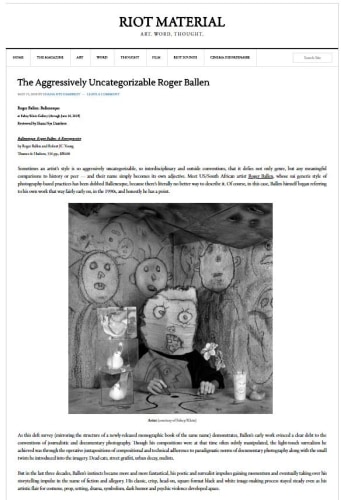
Sometimes an artist’s style is so aggressively uncategorizable, so interdisciplinary and outside conventions, that it defies not only genre, but any meaningful comparisons to history or peer — and their name simply becomes its own adjective. Meet US/South African artist Roger Ballen, whose sui generis style of photography-based practices has been dubbed Ballenesque, because there’s literally no better way to describe it. Of course, in this case, Ballen himself began referring to his own work that way fairly early on, in the 1990s, and honestly he has a point.
As this deft survey (mirroring the structure of a newly-released monographic book of the same name) demonstrates, Ballen’s early work evinced a clear debt to the conventions of journalistic and documentary photography. Though his compositions were at that time often subtly manipulated, the light-touch surrealism he achieved was through the operative juxtapositions of compositional and technical adherence to paradigmatic norms of documentary photography along with the small twists he introduced into the imagery. Dead cats, street graffiti, urban decay, nudists.
But in the last three decades, Ballen’s instincts became more and more fantastical, his poetic and surrealist impulses gaining momentum and eventually taking over his storytelling impulse in the name of fiction and allegory. His classic, crisp, head-on, square-format black and white image-making process stayed steady even as his artistic flair for costume, prop, setting, drama, symbolism, dark humor and psychic violence developed apace.
By circa 2000, he was in full Ballenesque mode. His casting of, let’s say, quirky models and his knack for dressing a set to look both majestic and squalid, romantic and repulsive, combined with the frequent involvement of random animals, dolls, masks, and domestic furniture to give the combined whole the internal logic and fearsome familiarity of a fever dream. At the same time, the use of black and white gives the images the confidence of an historical record.
From coy allegorical self-portraits like the folkloric outsider in Artist (2014) and the regal exhaustion of Introspection (2001), to the epic irreligiosity of Ascension (2013), and the ridiculous charm of Roar (2002), it seems Ballen never met an image-making strategy he didn’t like. Seen a few at a time, the fiction is not nearly as overt as in totality, each one on its own has a chance at believability, as though the artist had come across the fantastical scene and was lucky to have his camera with him.
Seen with so many assembled (and that merely a fraction of the whole) it becomes quite obvious that the scenes are constructed, with a singular vision at the helm. The joy of the exhibition then becomes a full exploration of the multifaceted theatricality of the “set production” and a tracing of recurring images throughout the many subseries. Without depriving audiences of the joy of discovering your own path through the lexicon, keep an eye out for Jungian greatest hits like hand-made masks, spirit animals, primitive wall drawings and pictures-within-pictures. After all that, not only the style, but the experience of it, can truly only be described one way — Ballensque.
Shana Nys Dambrot is an art critic, curator, and author based in Downtown LA. She is the Arts Editor for the LA Weekly and a contributor to numerous publications, including Riot Material. She sits on the Boards of Art Share-LA and the Venice Institute of Contemporary Art, and the Advisory Council of Building Bridges Art Exchange.